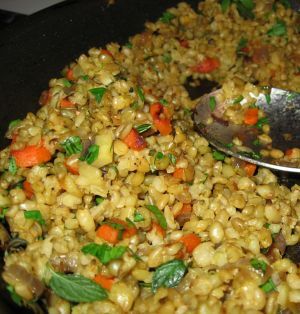Truth matters. Community matters. Your support makes both possible. LAist is one of the few places where news remains independent and free from political and corporate influence. Stand up for truth and for LAist. Make your year-end tax-deductible gift now.
This is an archival story that predates current editorial management.
This archival content was written, edited, and published prior to LAist's acquisition by its current owner, Southern California Public Radio ("SCPR"). Content, such as language choice and subject matter, in archival articles therefore may not align with SCPR's current editorial standards. To learn more about those standards and why we make this distinction, please click here.
What the Freekah?

A few weeks ago, while perusing the offerings behind the glass at the Surfas café, I noticed a bowl of green grains labeled “Freekah salad”.
“What’s that taste like?” I asked.
“It’s easier if you just try it,” said the friendly lad behind the counter, handing me a spoonful.
I ate it. I frowned. Then I smiled.
“Did you add that smoke in a bottle stuff to it? It’s so smoky!”
“Nope,” he said. “It tastes like that naturally.”
Huh?
Freekah is quite a puzzle. It’s hard to find a comprehensive description of it on the Internet. First of all, everyone seems to spell it differently: freekah, freekeh, frik, frekeh… All I know is it’s as fun to say as it is to eat.
Freekah is said to hail from Syria, where it is a traditional way to eat wheat. This site has great photos of the process by which these beautiful green grains make it to our table. I’ve also seen a few places link it to North Africa. And apparently they talk about it in the bible.
More on how freekah is made and a recipe after the jump!
So what is it? A pithy description is "parched green wheat". Durum wheat, the same kind used to make most pasta, is harvested before its ripe, which I'm guessing is where the "green" part comes from.
Then, it's laid out to dry in the sun for a few hours.
Then, the magic part: They BURN it! Apparently, during the season, you can see white plumes of smoke in the air where people are burning wheat. They usually burn it on the ground, on a bed of barley grass. The flames gently lick the green grains, imparting that delicate smoky flavor. They can also apparently burn over cumin, which I'm sure would only make it taste all the more delicious. The process came about as a smart way to enjoy some of your wheat crop before it was ripe enough to harvest.
It seems to be used in the same way as bulgar (cracked wheat) and rice, and since it has such a sturdy flavor, it can stand up to the most your kitchen has to offer (bring on the harissa and roasted autumn veggies). I've also seen it used in stew recipes, probably in the same way as barley. Yum, imagine a smoky freekah-beef stew!
As I said, I found it at Surfas (for an astronomical $12.99 for 20oz), but you can apparently find it in Middle Eastern grocery stores too. I'll have to check out some of those on Westwood. I have been making it according to a recipe I found at Surfas, which they reprinted from an issue of Bon Appetit. I adapted it a little and served with a grilled flank steak and vegetables. It was delicious. This is an unusual grain to add to your larder, and easy to adapt to whatever you have left in the fridge. You have to frickin' try it! (Sorry I couldn't resist).
Freekeh Salad (adapted from Bon Appetit recipe)
Serves 4
1 cup freekeh
2 ½ cups vegetable broth
1 cinnamon stick
1 garlic clove
½ tsp ground nutmeg
2 carrots diced peeled carrot
1 medium red onion, diced
1 tbsp minced ginger
¼ tsp ground allspice (optional)
2 tbsp olive oil
whatever fresh herbs you have, chopped (mint and parsley work well, as do chives)
1 tsp grated lemon peel
salt and pepper to taste
1) Rinse the freekeh. Drain, then place in a medium bowl. Cover with hot water and allow to soak for about 30 minutes. Drain.
2) Place freekeh in a large saucepan. Add broth, cinammon stick, garlic clove and nutmeg; bring to a boil. Reduce heat to a gentle simmer, cover and cook until the liquid is absorbed and the freekah is tender but firm (about 40 minutes). Drain if necessary. Discard cinammon stick and garlic.
3) Heat oil in a medium skillet. Add onions, ginger and carrot, and sauté until tender. Add allspice if you wish and a dash of salt. Add freekeh and fold until combined. Take it off the fire, and add the lemon peel and fresh herbs. Taste and season with salt and pepper. Serve warm or at room temperature.
Photo by aarti for LAist







